THIS POST IS A PART OF A 31 DAY SERIES TO INVITE OUR KIDS INTO THE KITCHEN. FIND THE REST OF THE SERIES HERE.
Start inviting your kids into the kitchen to help you bake and cook, and it will not be long before the requests to use a knife begin. You can’t really blame them– being able to safely use a knife is a crucial skill for any home cook.
While we want to exercise caution when using any object that has the ability to slice or impale, we also shouldn’t underestimate our children’s capabilities or capacity to learn skills given the opportunity.
There are a variety of cutting tools and knives with which children can learn and still stay safe. As soon as a child can stand on a stool and work at the counter or table, there is a cutting tool he can use. Many tools are able to slice soft foods, and yet unable to do any damage to a child’s fingers.
The following content was originally published over a year ago, but I wanted to update it and share it again in this series because there is a lot of helpful info and tips.
Teaching Knife Skills to Kids
When?
There are three things to look for which indicate your child may be ready to start learning to use a cutting tool in the kitchen.
- Ability to stand on a stool or chair and balance while working at the counter. Your child will be focused on working with his hands, so if he is still a little unsteady on his feet he is not ready.
- Interest in working in the kitchen. It is much more difficult to teach someone who isn’t interested in learning. If your child is more interested in doing other things, don’t push him. Simply keep the invitation open and be ready for when the mood strikes.
- Listening skills. This is certainly a skill that develops gradually with time, but it is very important when working together in the kitchen. Even experienced young chefs sometimes get kicked out of the kitchen when they are not exercising listening skills. Mama don’t play.
When your children are very young, keep the learning sessions short– even just five minute increments. Take advantage of the short focus time to give them undivided attention to work on a specific skill. Then let them run off whenever they are ready.
How?
1. Model safety.
The first step in our children developing new skills is usually watching other people. They are constantly picking up on what we do and what we say. So before ever handing a child a knife, they should see you demonstrating safe handling of knives and have a solid understanding of how they are used (and how they should not be used).
2. Start with plastic & learn the movement.
Before my children ever used a real knife, they had hours of practice slicing and dicing play-doh. They have plastic lettuce knives (similar to a chef’s knife) as well as plastic butter knives. Using knives like these, which are essentially like the real thing only plastic, gives them the opportunity to learn how to safely hold and use knives.
Even though they are using plastic knives and playing with play-doh, it is important to emphasize that they should still use them appropriately. This means no waving them around, slamming them down like an axe, or using them for anything other than cutting. I don’t want them developing bad habits that will show up later.
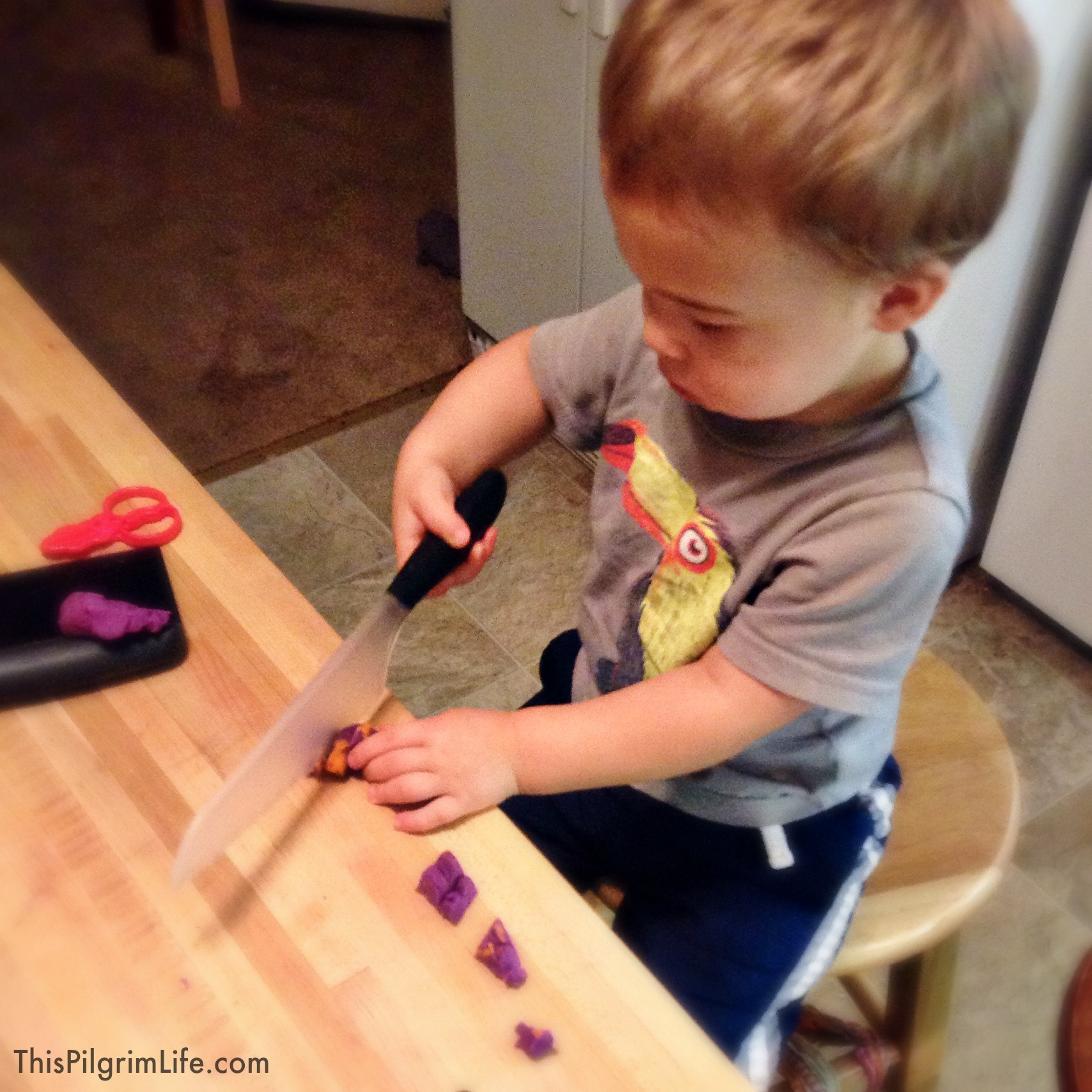
3. Supervise, supervise, supervise!
Be near and observant once you take the next step into introducing a real cutting implement. Don’t be distracted. If you need to take your attention away for a few minutes, take the knife away too.
4. Choose the right implement.
Once you feel your child is ready to take the next step, choose a cutting implement that suits his age, ability, and maturity. I will explain a few options below.
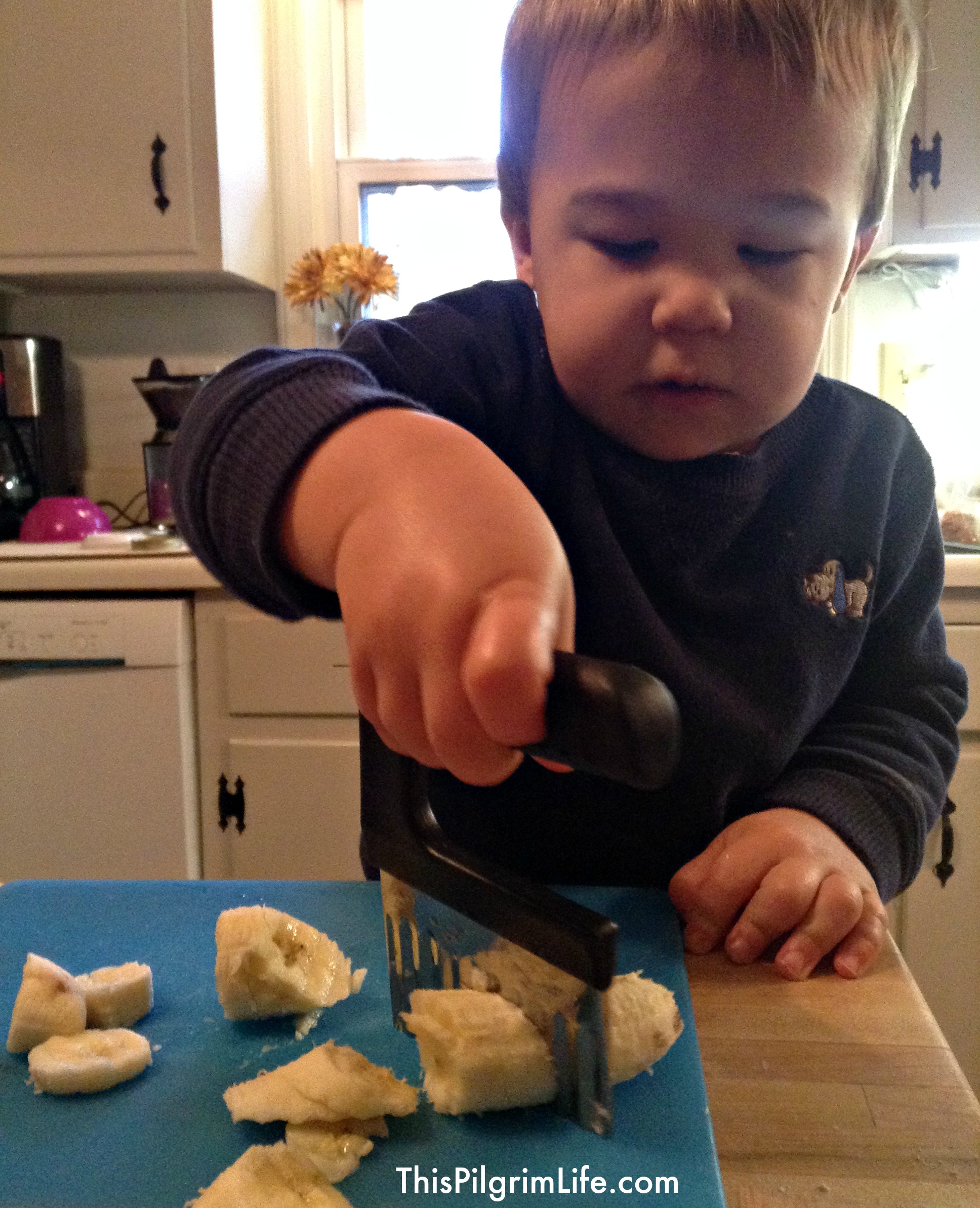 Forgive my mama heart while I ooh and ahh over how little he was!
Forgive my mama heart while I ooh and ahh over how little he was!
5. Show them correct form.
Teach your child the proper way to hold a knife and where to put his other hand. Also important is teaching your child when to simply press down to cut, and when it’s appropriate to use a sawing motion to cut.
6. Practice.
In order to develop any level of competency, children need opportunities to practice. Often, I will let my children help me cut up vegetables or fruit that will be used for whatever meal I’m preparing. There are times, though, in which this isn’t an option.
If I still want them to be in the kitchen with me, and if they are still eager to participate, I will give them a piece of produce that I don’t mind using just for that purpose. Carrots and apples make good cutting practice because they can just eat the pieces as they chop them up.
7. Dialogue.
One of my favorite aspects of being together in the kitchen with my children is being able to talk with them. This is how they will learn vocabulary like “chop”, “dice”, “mince”. Talk all about what you are preparing. The method. The health benefits. And, not to be underestimated, this is another opportunity to affirm their efforts and strengthen your relationship.
What?
The knives below are all ones which we use in our kitchen and which I can wholeheartedly recommend. They are listed in order of safety, development, and usefulness:
Lettuce Knives
A few years ago I found one of these at Target, but when I wanted to get a second one for my younger son several months ago, I had a hard time locating one. I finally found one at a local kitchen specialty store. So if you get tired of the hunt, just order online. {Update: I often see these stocked at Hobby Lobby}
Plastic picnic knife
You probably already have some around the house. They can be a great first step in learning to handle a knife.
Crinkle Cutter
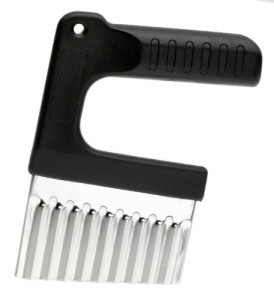
This is a tool used to “crinkle cut” vegetables. It is a wonderful first “knife” for toddlers too. Its handle makes it easy to hold onto and easy to get sufficient force to cut through vegetables.
Dog Knife
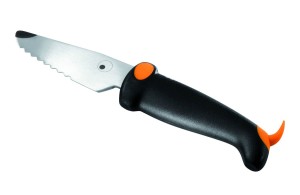
My two year old currently prefers this as his favorite cutting tool. It is sharp enough to cut through a lot of different types of produce, but not sharp enough to cut his fingers. (I will say, though, that the first day he used it he came down on his fingernail cuticle and that didn’t feel very good. But this was the only time he was “hurt” using it. Today he chopped carrots like a champ with his dog knife). Bonus: the knife has a face and a tail.
Paring Knife
This is a knife that I use many times a day. They are regular, sharp knives. They will cut fingers if used inappropriately. I would not recommend a child using these until you feel that they have enough skill to cut without fingers getting in the way.
My oldest son, who will be 4 in June, has been using paring knives for at least a few months. He worked his way up through the knives mentioned above and now has the dexterity and skill to be able to use paring knives safely. He is also getting quite good at uniform slicing and chopping!
Do your children like to help you in the kitchen?
Have you started teaching them how to safely use a knife?
Find the rest of the Kids in the Kitchen posts on the series page.
EACH WEEK I LINK UP WITH MOTIVATION MONDAY, MODEST MAMA, MAMA MOMENTS, TUESDAY TALK, AND WORKS FOR ME WEDNESDAY. THE LINKS ABOVE MAY ALSO BE AFFILIATE LINKS, MEANING I EARN A SMALL COMMISSION AT NO EXTRA COST TO YOU. I APPRECIATE YOUR SUPPORT OF THIS SITE!

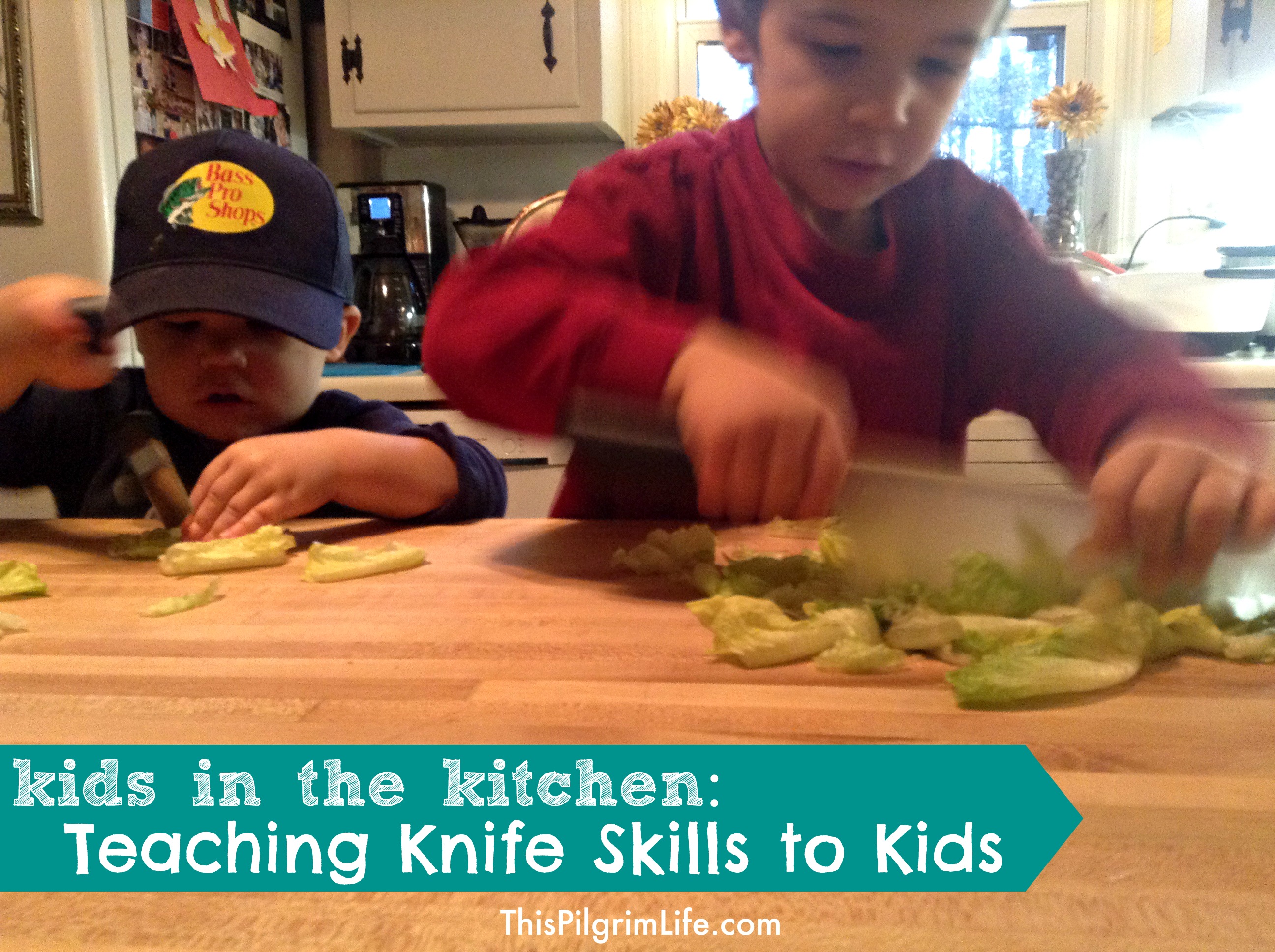


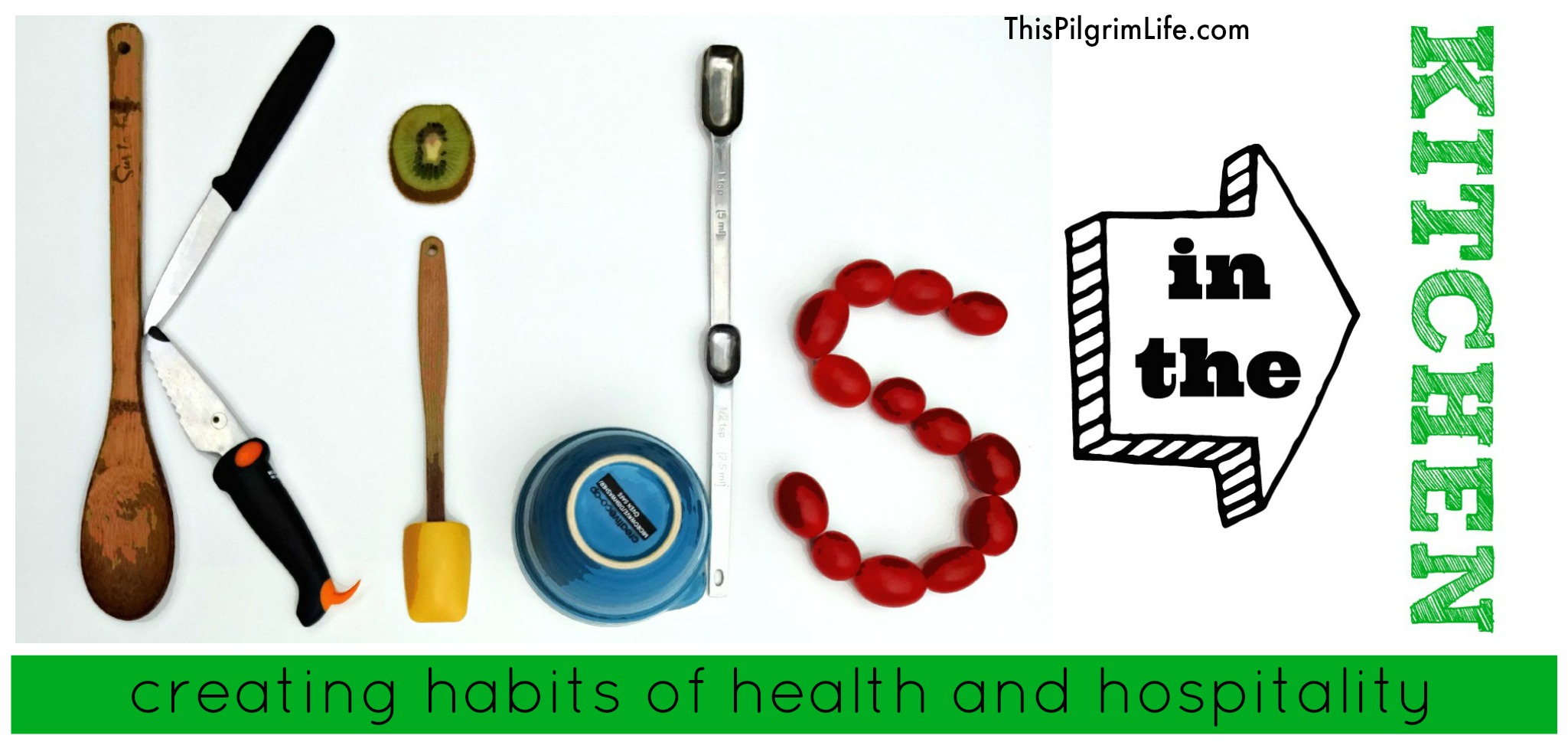
Wao! I absolutely loved this article on the many ways to improve your knife skills. I truly love the art of cooking and it is wonderful that you share your precious wisdom with us. If you wish to expand and teach other enthusiasts such wonderful skill of cooking, I suggest you checkout our skills exchange platform Kool Stories. Thank you so much for the insightful article 🙂
Great tips. Always love to have this kinds of lovely article. I’m sure my kids will love to learn this skill. Thanks a lot.
Thanks for your post. Totally what I’m looking for my research about children safety.
When I was a kid, I have really enjoyed helping mom in the kitchen, even thou my parent for safety purpose, tricked me and got me plastic knives. and I spent days trying figure out why I can’t peel tomatoes lol
Great article xD
It is very helpful tips for every kid how to teach and maintain any types of knife. Thanks for sharing this helpful tips.
Thank you very much for sharing this post. You have given your title “KITCHEN KNIFE SAFETY FOR KIDS” Yes it is safety for kids when it would be plastic or not shiny. But when you give to your kids stainless steel knife i think it would be very dangerous thing for them.
Your article is also well written i appreciate your write.
Yes! My kids love helping out in the kitchen. They get intimidated by larger chef knives, so I’ve started letting them use nylon knives at first and then slowly graduate up to using smaller steel versions.